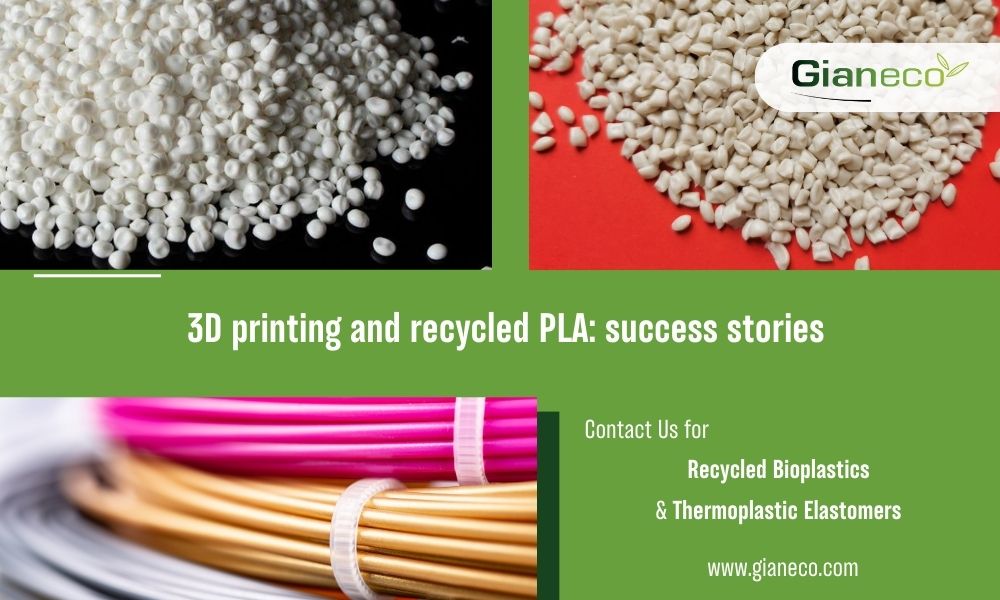3D printing is a rapidly growing technology with applications in a wide range of industries. There are many 3D printing materials that can be used, from polymers to metals, from ash to recycled plastics.
One of the most widely used materials in 3D printing, especially for fused deposition modeling or FDM, is PLA, a biopolymer derived from corn or sugar beet starch.
PLA is a biodegradable and recyclable material, making it a sustainable option for 3D printing, but more importantly a very easy plastic to print. And this makes it the ideal filament even for the inexperienced.
In this article we will delve into some of the issues related to selecting the right material for 3D filament production and the opportunity presented by the availability of recycled PLA on the market.
Moreover, 3D printing with recycled PLA filament is a sustainable and affordable option for 3D printing.
We will then go on to detail some success stories of companies that have opted to use recycled polylactic acid to produce 3D filament with a view to reducing their environmental impact and sustainable marketing.

Differences between PLA and recycled PLA in the 3D filament manufacturing business
PLA and recycled PLA remain among the most widely used materials because they allow a wide variety of colors, little thermal expansion, and, most importantly, do not generate bad odor during printing.
Advantages found by 3D filament manufacturers include: low printing temperature (around 200 °C), excellent visual and physical performance, and, in particular, no need for a heated platen.
Recycled PLA is the most welcome option for prototype printing. It is cheap and easy to print, making it an ideal option for testing new ideas.
But recycled PLA is not only used for prototypes. Customers of the Gianeco company, a producer of PLA granule for 3D filament production, also successfully make gadgets, accessories and ornaments such as key chains, phone cases, earrings, bracelets, necklaces, objects, figures, and vases.
One of the most frequent uses is in the toy world for characters, figurines, models, animals, vehicles, game parts.
3D printing with recycled PLA filament is a similar process to 3D printing with virgin PLA filament. However, there are some differences to keep in mind.
Recycled PLA filament is made from waste materials, such as plastic bottles and food packaging. This means the filament can have a variety of colors and textures.
The melting temperature of recycled PLA filament may be slightly different from virgin PLA. It is important to check the filament manufacturer's recommended temperature.
Some 3D printer settings may need to be adjusted to achieve optimal results with recycled PLA filament. For example, you may need to increase the print speed or reduce the amount of fill.
Some success stories
There are already several success stories testifying to the potential of recycled PLA in 3D printing.
For example, the U.S. company Formlabs has launched a new line of 3D printers that use exclusively recycled PLA. The company says this choice has reduced carbon emissions by 75 percent compared to using virgin PLA.
Another success story is that of the Italian company Nimbus 3D.
This company has developed a PLA recycling technology that allows the material to be recovered from 3D printed objects. Nimbus 3D offers its customers the ability to return 3D printed objects so they can be recycled and reused.
Gianeco: a sustainable supplier of recycled PLA and other biopolymers
If you are already using virgin PLA and would like to test recycled PLA, contact Gianeco now. Among recycled Pla producers, Gianeco stands out for having believed in bioplastics and recycled bioplastics at an early stage.
For almost ten years, Gianeco has been collecting bioplastic waste and making granules and ground PLA, PBAT and PBS.
Gianeco's recycled PLA products are a sustainable choice for companies wishing to reduce the environmental impact of their products.
See the dedicated section on
Biogeo branded recycled bio materials.
Below are the contact details of Gianeco's Bioplastics Responsible:
Viktoriia Krykun





